The AMD Ryzen Threadripper 3960X and 3970X Review: 24 and 32 Cores on 7nm
by Dr. Ian Cutress, Andrei Frumusanu & Gavin Bonshor on November 25, 2019 9:05 AM ESTCPU Performance: Encoding Tests
With the rise of streaming, vlogs, and video content as a whole, encoding and transcoding tests are becoming ever more important. Not only are more home users and gamers needing to convert video files into something more manageable, for streaming or archival purposes, but the servers that manage the output also manage around data and log files with compression and decompression. Our encoding tasks are focused around these important scenarios, with input from the community for the best implementation of real-world testing.
All of our benchmark results can also be found in our benchmark engine, Bench.
Handbrake 1.1.0: Streaming and Archival Video Transcoding
A popular open source tool, Handbrake is the anything-to-anything video conversion software that a number of people use as a reference point. The danger is always on version numbers and optimization, for example the latest versions of the software can take advantage of AVX-512 and OpenCL to accelerate certain types of transcoding and algorithms. The version we use here is a pure CPU play, with common transcoding variations.
We have split Handbrake up into several tests, using a Logitech C920 1080p60 native webcam recording (essentially a streamer recording), and convert them into two types of streaming formats and one for archival. The output settings used are:
- 720p60 at 6000 kbps constant bit rate, fast setting, high profile
- 1080p60 at 3500 kbps constant bit rate, faster setting, main profile
- 1080p60 HEVC at 3500 kbps variable bit rate, fast setting, main profile
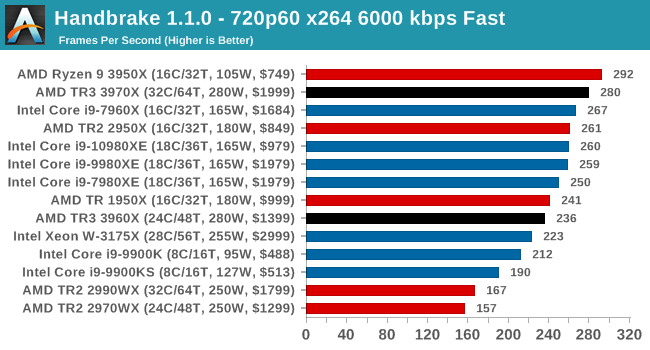
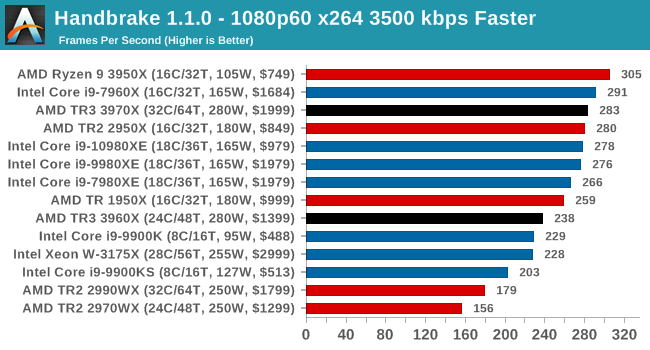

Video encoding is a little varied, based on the variable threaded nature. Certain encoding tests can be more memory sensitive here, or accelerated in different ways, or not scale well with more cores. Either way, TR3 performs a lot better than TR2, but the 3950X seems the best choice.
7-zip v1805: Popular Open-Source Encoding Engine
Out of our compression/decompression tool tests, 7-zip is the most requested and comes with a built-in benchmark. For our test suite, we’ve pulled the latest version of the software and we run the benchmark from the command line, reporting the compression, decompression, and a combined score.
It is noted in this benchmark that the latest multi-die processors have very bi-modal performance between compression and decompression, performing well in one and badly in the other. There are also discussions around how the Windows Scheduler is implementing every thread. As we get more results, it will be interesting to see how this plays out.
Please note, if you plan to share out the Compression graph, please include the Decompression one. Otherwise you’re only presenting half a picture.
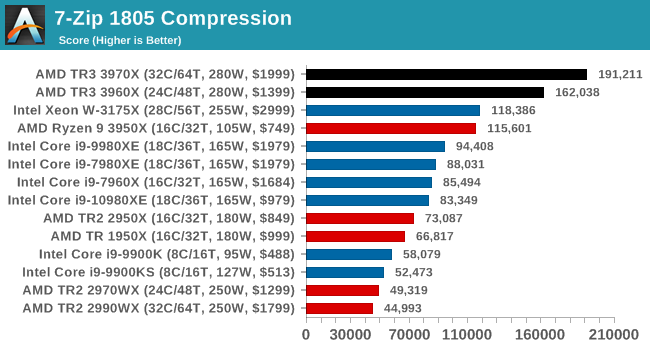
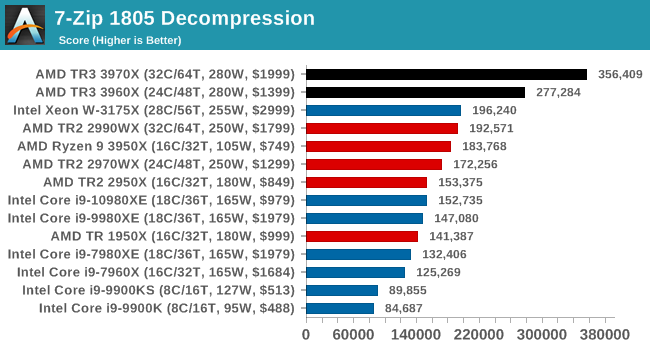
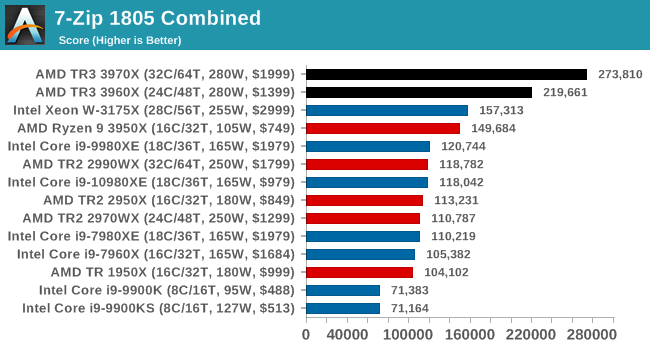
Easily parallel puts the TR3 well ahead of TR2 and Intel.
WinRAR 5.60b3: Archiving Tool
My compression tool of choice is often WinRAR, having been one of the first tools a number of my generation used over two decades ago. The interface has not changed much, although the integration with Windows right click commands is always a plus. It has no in-built test, so we run a compression over a set directory containing over thirty 60-second video files and 2000 small web-based files at a normal compression rate.
WinRAR is variable threaded but also susceptible to caching, so in our test we run it 10 times and take the average of the last five, leaving the test purely for raw CPU compute performance.
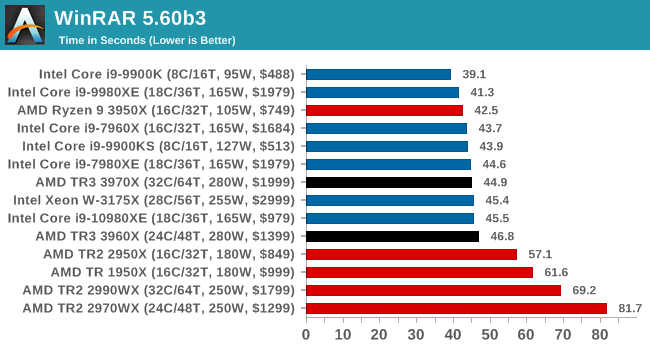
WinRAR is a variably threaded application, and both TR3 processors perform in the same ballpark as anything from Intel. Ideally we should have seen them streak ahead, but we seem to be at a point where CPU frequency or core counts are the limiting factor. At least with Zen 2, there are no issues as there was with Zen 1/Zen+.
AES Encryption: File Security
A number of platforms, particularly mobile devices, are now offering encryption by default with file systems in order to protect the contents. Windows based devices have these options as well, often applied by BitLocker or third-party software. In our AES encryption test, we used the discontinued TrueCrypt for its built-in benchmark, which tests several encryption algorithms directly in memory.
The data we take for this test is the combined AES encrypt/decrypt performance, measured in gigabytes per second. The software does use AES commands for processors that offer hardware selection, however not AVX-512.











245 Comments
View All Comments
jmelgaard - Monday, November 25, 2019 - link
They also somehow forgot that AMD has been virtually invisible in the desktop CPU market for the last ~10 years, yet they managed to survive and pull this incredible victory.But for some reason, that would be unthinkable that Intel could turn things around... o.O... Pure idiocracy...
Besides, it doesn't matter if your an AMD or Intel fan, if you don't wan't both to be in the game your a pure moron, the status quo we have seen from Intel the past 10 years is exactly what we will see if they aren't both in the game. They are there to push each other, to the overall benefit for us, the consumers. If Intel really where to go out of business, then AMD would just begin to milk...
It's f****** amazing how dumb some people are...
AMD has the absolute and clear victory this time, if Intel has anything meaningful to respond with in the near future, well only time can tell...
But for now... Lets just praise what AMD has done, cheer for the amazing launch and well earned victory after what can only have been 10 long years of hard work, and hope that Intel returns... Hopefully sooner than AMD did... Or... On the other hand it's been 10 rather cheap years computer wise for me, so... perhaps I should cheer for Intel to take 10 years for a decent knockout punch in the other direction...
DannyH246 - Monday, November 25, 2019 - link
Intel will DEFINITELY return and with Jim Keller on board i'm sure in 2-3 years they will return with a vengeance. I do hope however that everyone remembers what we have been saddled with from Intel for the last 10 years...No innovation, crazy pricing, artificial market segmentation, forced new motherboard purchases every year etc etc. In short - Intel have shafted us for years and are only working like crazy now because AMD launched a rocket up their back sides. Lets hope AMD continues innovating & executing as they have been. That's not Fanboyism, its just common sense.lobz - Tuesday, November 26, 2019 - link
What gap in IPC? You think intel's Coffee Lake has a higher IPC than Zen 2? Please get your facts straight before you try to criticize other people's comments.Der Keyser - Monday, November 25, 2019 - link
AMD are really doing wonders with their ZEN2 architecture :-)But with the latest pricing of the higher end R7 and R9 and now TR I think they are making a GREAT mistake. They have decided to capitalize on having reached their target of beating Intel on performance. So prices are no longer vastly better than Intel, and we are moving into having AMD/INTEL pricing close enough not to matter to the average consumer.
This is a very short sighted decision as AMD right now has a once in a lifetime opportunity to really kick Intel in the n***. Intel’s production capability and proces node is lagging - as is their architecture. This is the time to set pricing and performance at a level were DELL, HP, LENOVO and so on are unable to ignore or downplay the AMD option because of intel funding - because that is happening now, and will continue when AMD is getting similarly expensive.
Ditch the lower end SKU’s and drop the prices on mid and high-end SKUs with 20 - 30% now and gain what AMD never had before: Market superiority to really establish their name as a household processor brand. Will all know Intel will retaliate within the next two years once their 10 and 7nm comes full online, and once that happens, AMD will once again battle with the “unproven and small player” moniker because they never got REALLY big - Getting rid of that moniker should be their second and REAL goal of this ZEN2 era. This short term money grab with the new pricing is what will keep AMD in the shadows of Intel going forward.
liquid_c - Tuesday, November 26, 2019 - link
This! So much this! I have no brand loyalty but somehow, people either chose to forget all of AMD’s mishaps (fake turbo boosts, pricing during their Athlon days, declaration of MB compatibility with future CPU gens but when time comes, they point fingers at MB vendors, etc.)liquid_c - Tuesday, November 26, 2019 - link
...or they hate Intel that much (no edit button..)Korguz - Tuesday, November 26, 2019 - link
liquid_c looks like you may be used to the way intel does things, have you seen this article :https://www.anandtech.com/show/15137/amd-clarifies...
or this one :
https://www.anandtech.com/show/14873/reaching-for-...
and what about intels TDP ratings on their cpus ?? people harped and criticized amd for the power their cpus used before zen, but, yet, when intel does the same... it seems to be ok ??
or, that just hate amd that much ....
peevee - Monday, November 25, 2019 - link
Too bad the test actually relevant to the class of CPUs, namely compilation, is gone.Also looks like some results are old, before OS and BIOS patches for security (Intel) and performance (AMD).
tony p - Monday, November 25, 2019 - link
does anyone know can I swap CPU heatsink between Socket TR4 and TR3Slash3 - Tuesday, November 26, 2019 - link
X399 and TRX40 boards use the same physical socket - heatsinks are compatible with all three generations of Threadripper.